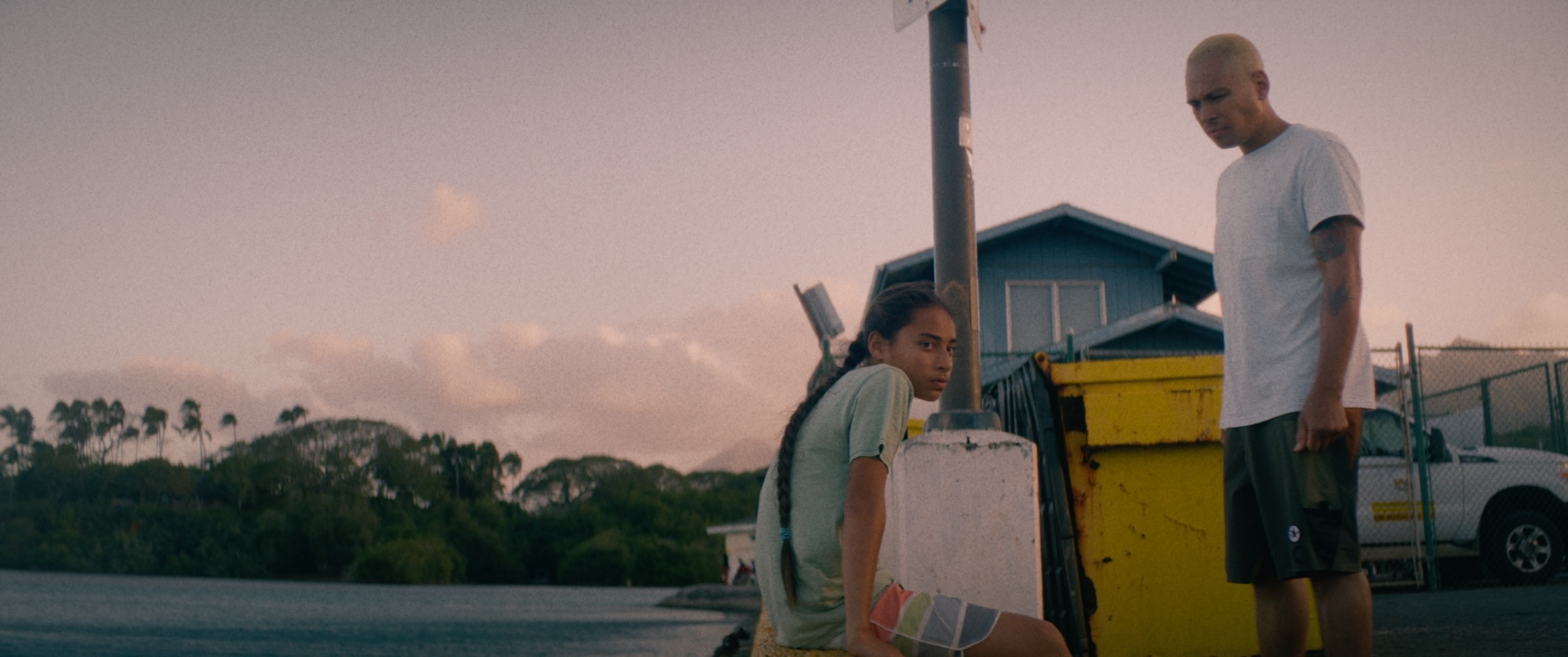This year at the Hawaiʻi International Film Festival, I watched some of the best films in indigenous cinema and representation of the local community here in Hawaiʻi. HIFF44 featured the premiere of its centerpiece presentation, Alika Tengan’s MOLOKA’I BOUND. I had been anticipating this film since seeing the original short a few years ago. Before discussing the feature, I would like to briefly mention the original short film.
In the short film, the visual of a Native Hawaiian father and his son against the backdrop of the Koʻolau mountains, along with their unique dynamic and chemistry, had stayed with me for years. The original short film follows Kainoa De Silva (Holden Mandrial-Santos), a recently released prisoner trying to mend his relationship with his son, Jonathan (Achilles Holt), whom he had with his ex-girlfriend, Jessica (Kalena Charlene). Throughout the short, they navigate their rocky reunion, as Jonathan pushes his father away and resents the fact that his father wasnʻt there for him. Kainoa attempts to connect with his son through many cultural touchstones familiar to locals.
It is so refreshing to see the island, culture, and community through Kainoa’s indigenous perspective. As someone who grew up here, I got goosebumps during the opening credits sequence, which shows Kainoa on the flatbed of a truck driven by his sister ʻŌlena (Kamalani Kapeleiela). The montage captures shots of the island, from the cityscape of Honolulu and the tunnels of the Pali to the wetlands of the windward side of Kaneohe. While this might not seem significant at first, what makes it unique and eye-opening is that the film was produced primarily by an indigenous cast and crew. This showcases Hawaiʻi beyond the stereotypical tourist gaze; it showcases areas of the island that have not yet been shown. The hand-held Cinéma vérité style of shooting presents both the audience’s and Kainoa’s perspectives. Although this style captures the island’s beauty, it also suggests a deeper story behind the “paradise.”
The dynamics between Kainoa and Jonathan drive the film and enable both characters to grow. Kainoa tries to make it in a world where Hawaiʻi and its community struggles to cope with a tough economy, high cost of living, homelessness, poor infrastructure, healthcare issues, and mounting bills. This struggle is reflected in the second act when Kainoa, while trying to stay clean, finds himself in the wrong place at the wrong time. Without spoiling the film, his attempts to reconcile with Jonathan lead him down a difficult path.
As they rekindle their bond, Kainoa takes Jonathan on a cultural journey. In one scene, reminiscent of the original short, Jonathan breaks his slippers, and Kainoa fixes them. Another callback shows them sharing one of Hawaiʻi’s favorite snacks: strawberry ropes with salt. These cultural references aren’t forced into the film but are cleverly integrated into scenes in ways that local Hawaiian audiences will relate to. I particularly appreciated the poi pounder scene featuring Justin Ah Chong (the film’s 1st AD & Co-producer). While the scene teaches the value of preserving Hawaiian cultural heritage, it leads to a humorous moment where Kainoa shares poi with Jonathan, who suggests it needs sugar—a moment that had the theater audience laughing in recognition.
The most important thing to Kainoa is his son, as he takes him on a cultural journey to rebuild their bond. In one memorable scene during a fishing trip, Jonathan breaks his slippers, and Kainoa, demonstrating both practicality and care, picks them up and fixes them, a scene that also happens in the original short. Another nod to the short occurs when Kainoa shares with Jonathan one of Hawaiʻi’s favorite snacks, strawberry ropes with salt. These cultural touchstones aren’t shoe-horned or forced into the film but are rather cleverly implemented in the scenes. I know local audiences here in Hawai’i will relate to them.
In addition, I loved that the feature included the poi pounder scene, featuring Justin Ah Chong (the film’s 1st AD and Co-producer), particularly stands out. The scene effectively teaches the value of preserving the cultural heritage of Hawai’i and includes a moment of levity when Kainoa shares poi with Jonathan, who says it needs sugar. I vividly remember the laughter of the audience in the theater. These authentic cultural elements and references help make the film especially appealing to the local community, as they deeply relate to us.
Watching this film as a lifelong local of Hawai’i, MOLOKA’I BOUND is a contemporary story set in Hawai’i that incorporates local elements of food, pidgin, and culture. This raises an important question: how can these authentic portrayals empower both the local community and those outside Hawaiʻi? To answer this, one must consider the historical and cultural context of Hawaiʻi. The film captures modern life in the islands, and I believe that it is important to view this place in a whole new context.

Richard Aiwohi-Kim born and raised here in Honolulu. He earned a Bachelors of Arts in the Art Studio and Digital Cinema at the University of Hawaiʻi at Mānoa. He is an aspiring filmmaker and artist and studies cinema history, media culture, ethics, and visual culture. Through UH, he has worked on almost a dozen student productions as an editor, production assistant, sound recordist, and DP.
The HIFF ONLINE CREATIVES & CRITICS IMMERSIVE (HOCCI) program supports sustainable film criticism in Hawaiʻi through mentorship and paid career opportunities for Hawaiʻi-based AANHPI critics. The mission of HOCCI is to broaden diversity in film criticism across the Pacific and use influencer branding strategies to spark career opportunities. The 2024 HOCCI is supported by Critical Minded, a grant-making and learning initiative that supports cultural critics of color in the United States.



